Abstract
Recent industry changes in swine-management practices have resulted in a growing controversy surrounding the environmental and public health effects of modern swine production. The numerous wastes produced by intensive swine production not only pose a significant challenge to effective environmental management but also are associated with decreased air quality in confinement houses, potentially transferable antimicrobial resistance patterns, and several infectious agents that can be pathogenic to humans. Published studies have documented a variety of contaminants, microbial agents, and health effects in those occupationally exposed to swine, and these have provided the groundwork for an increasing body of research to evaluate possible community health effects. Nonetheless, several factors limit our ability to define and quantify the potential role of intensive swine-rearing facilities in occupational and community health. Our incomplete understanding and ability to detect specific exposures; the complicated nature of disease etiology; pathogenesis; and surveillance; and the inherent difficulties associated with study design all contribute to the inadequate level of knowledge that currently prevails. However; an evaluation of the published literature; and a recognition of the elements that may be compromising these studies; provides the foundation from which future studies may develop.
Full text
PDF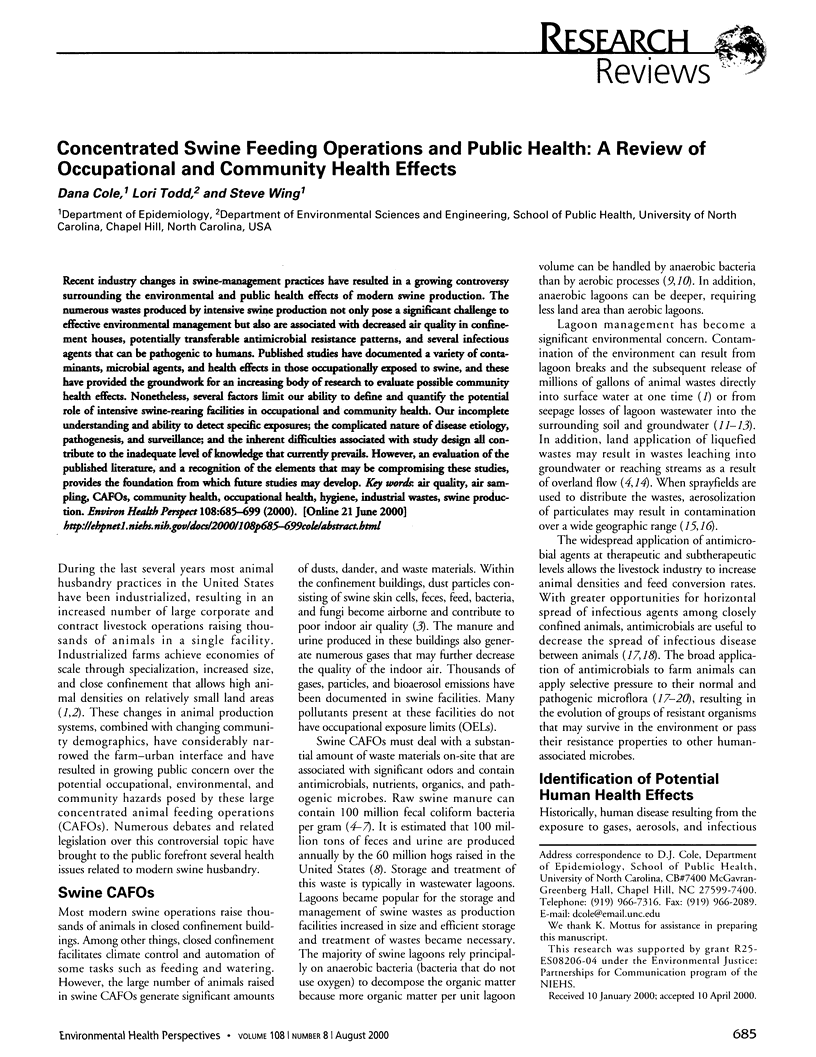
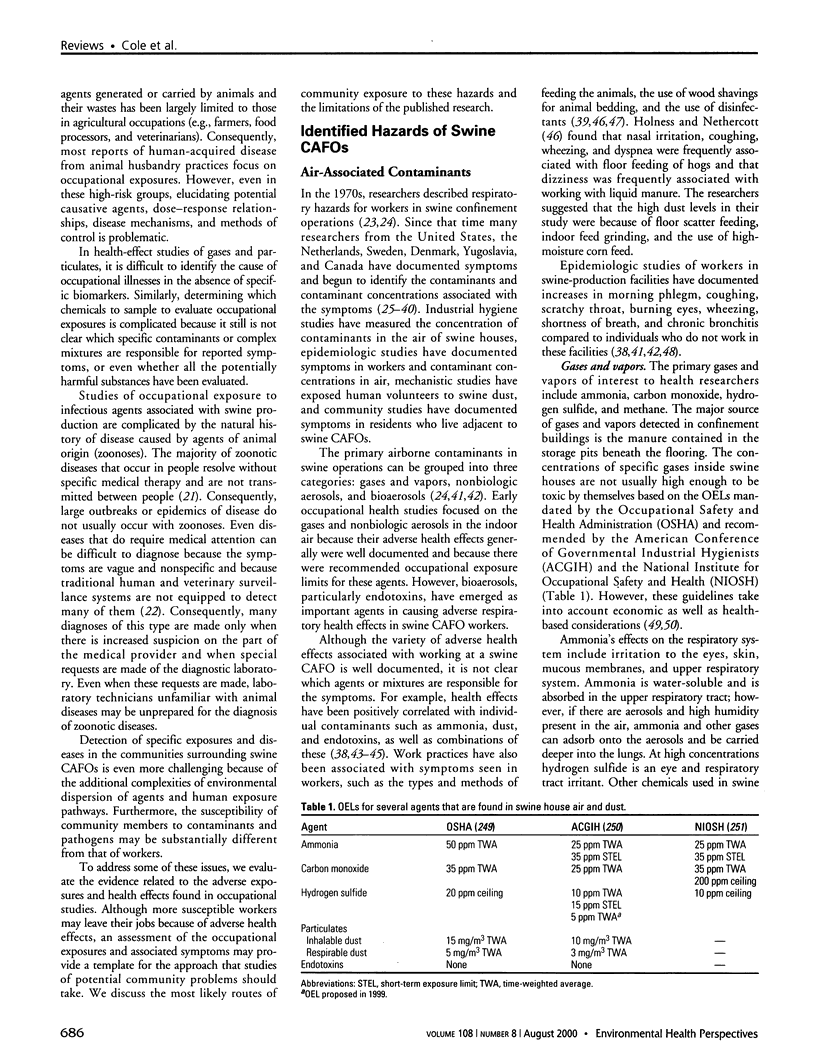
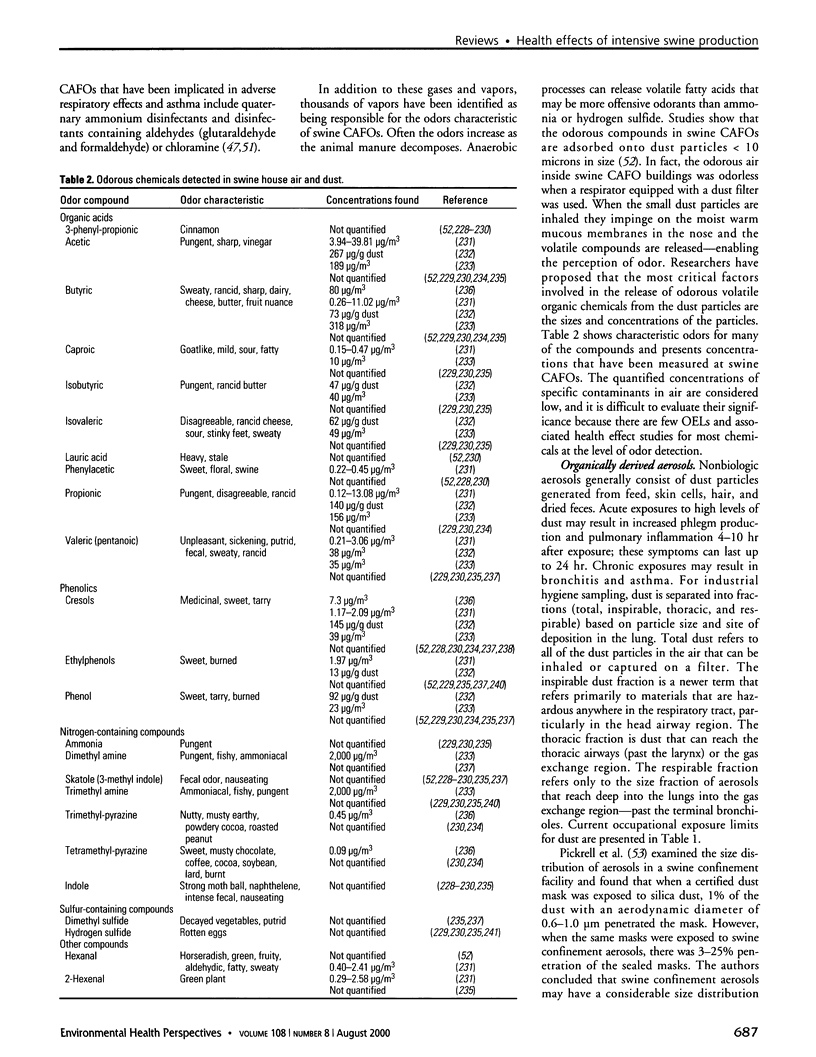
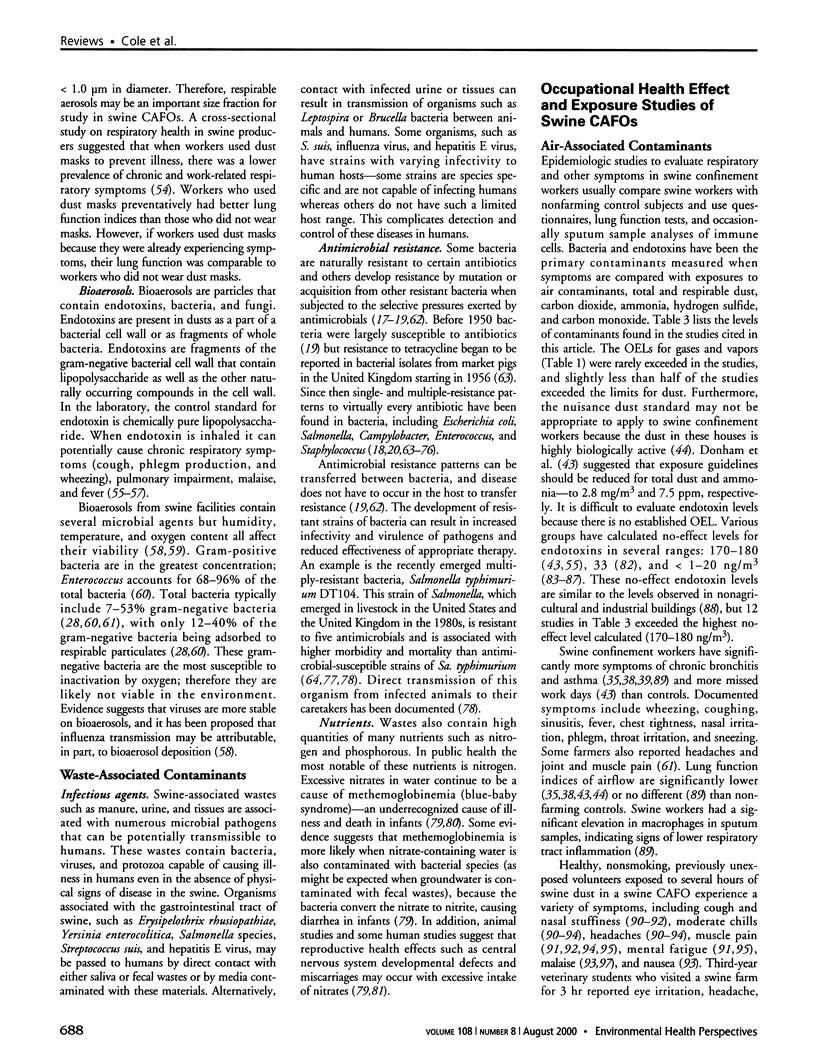
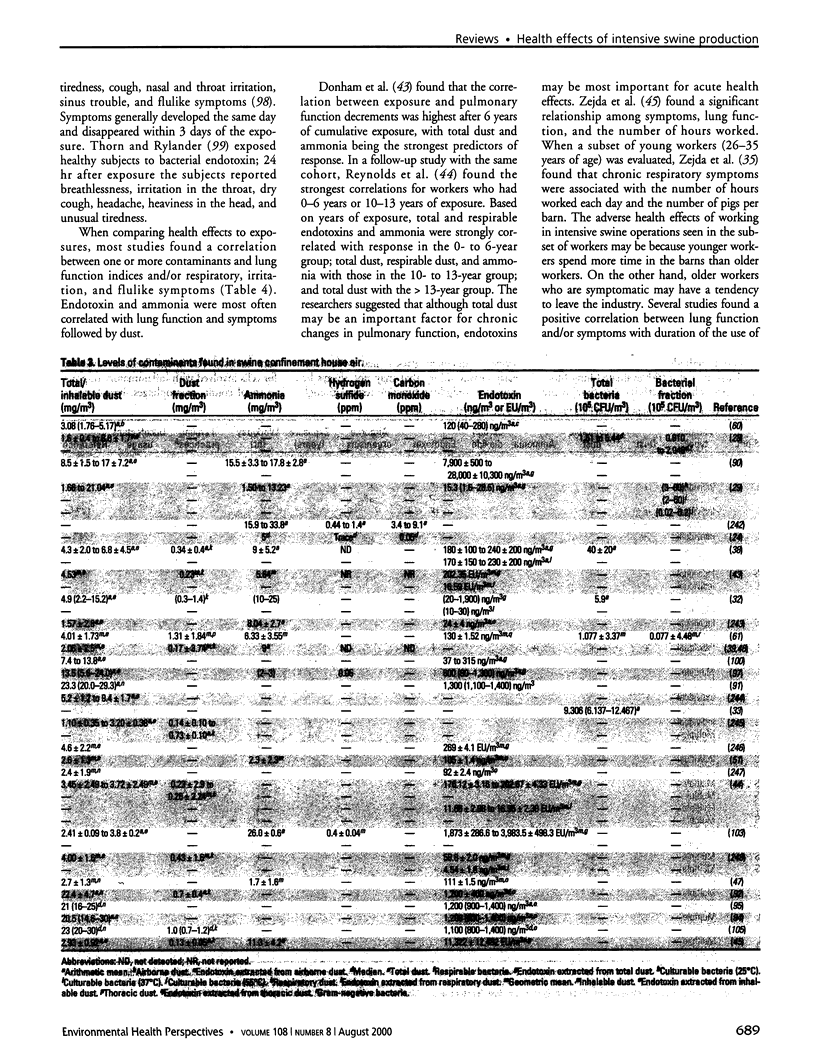
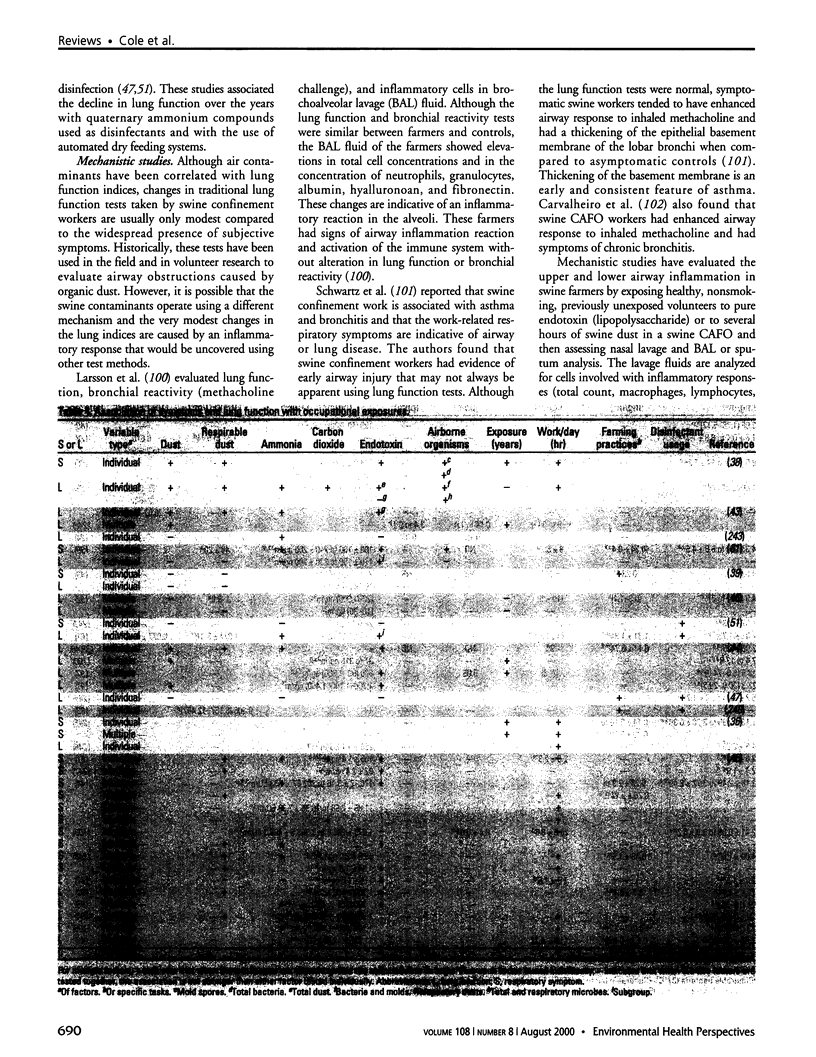
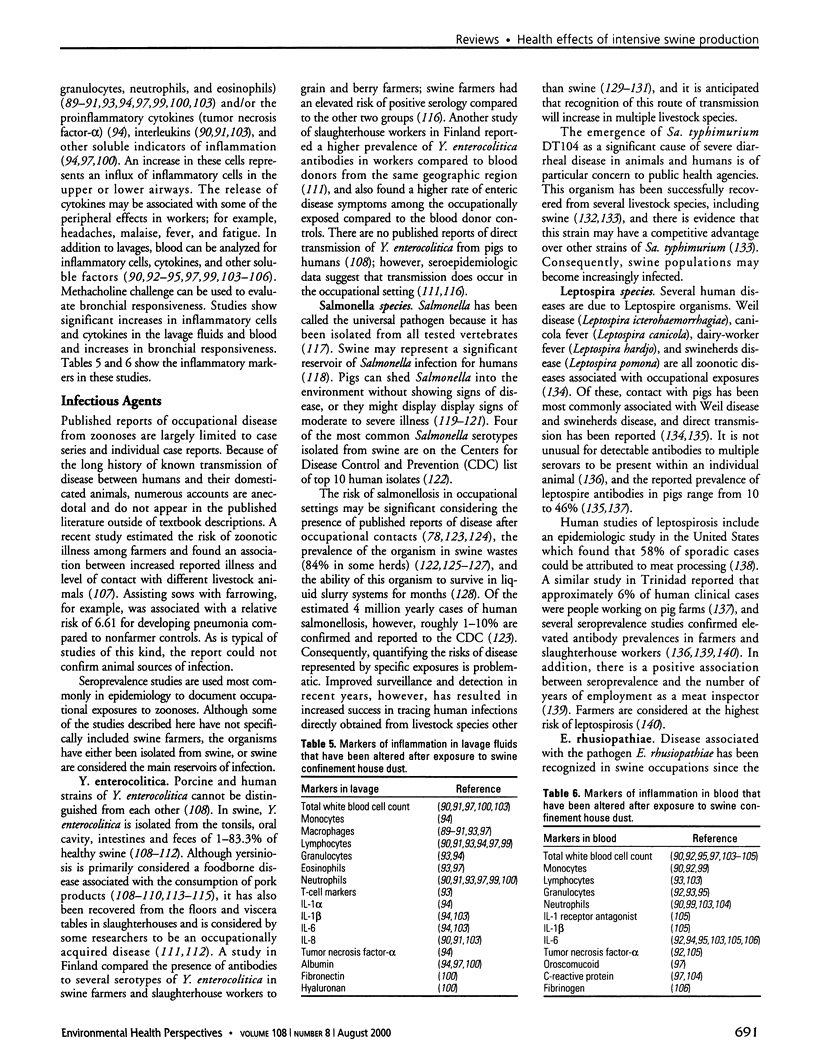
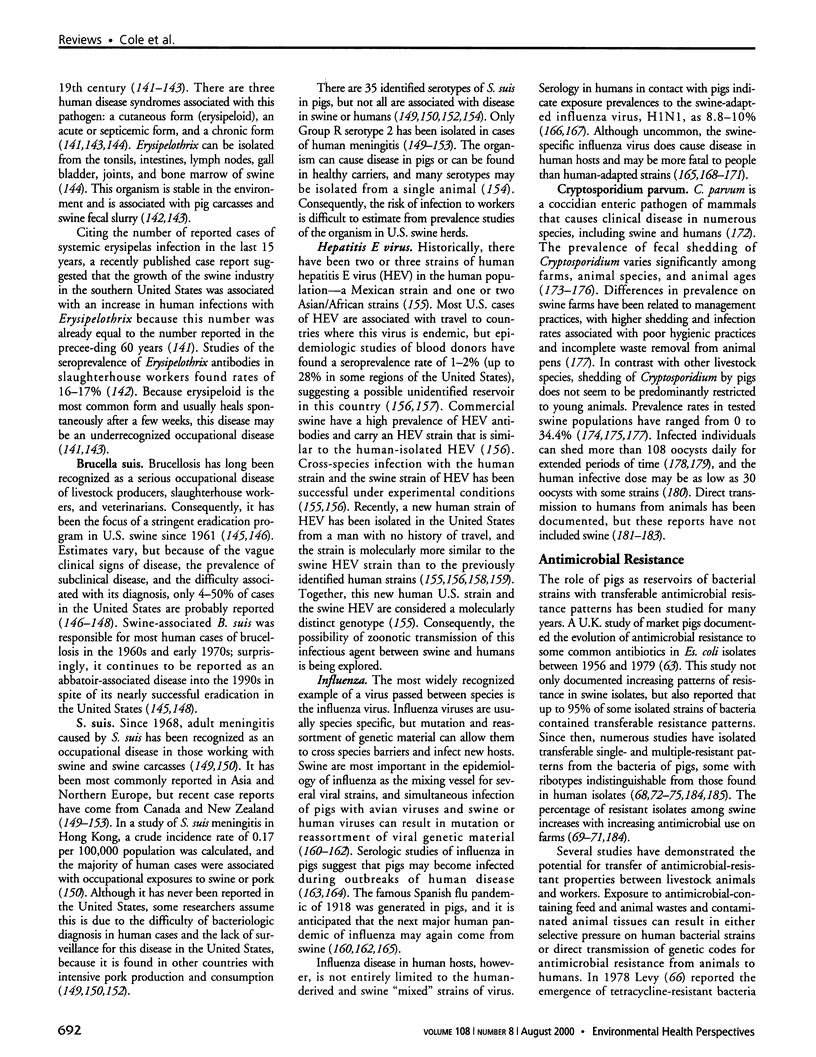
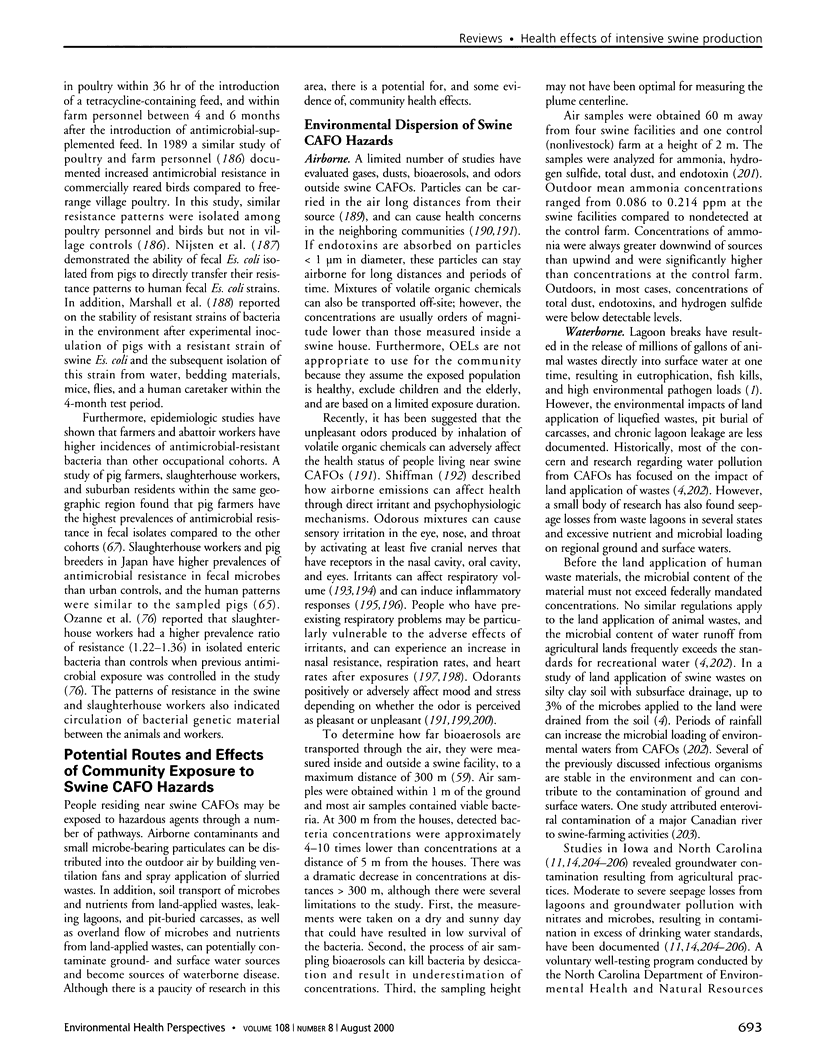
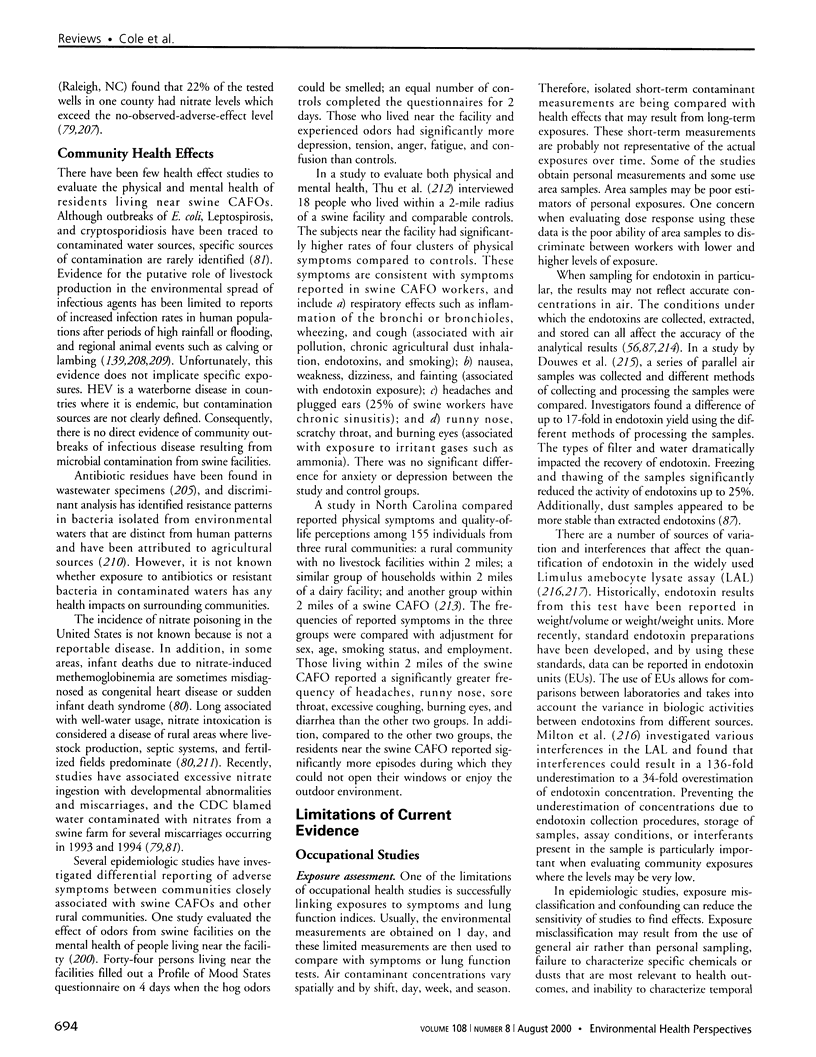
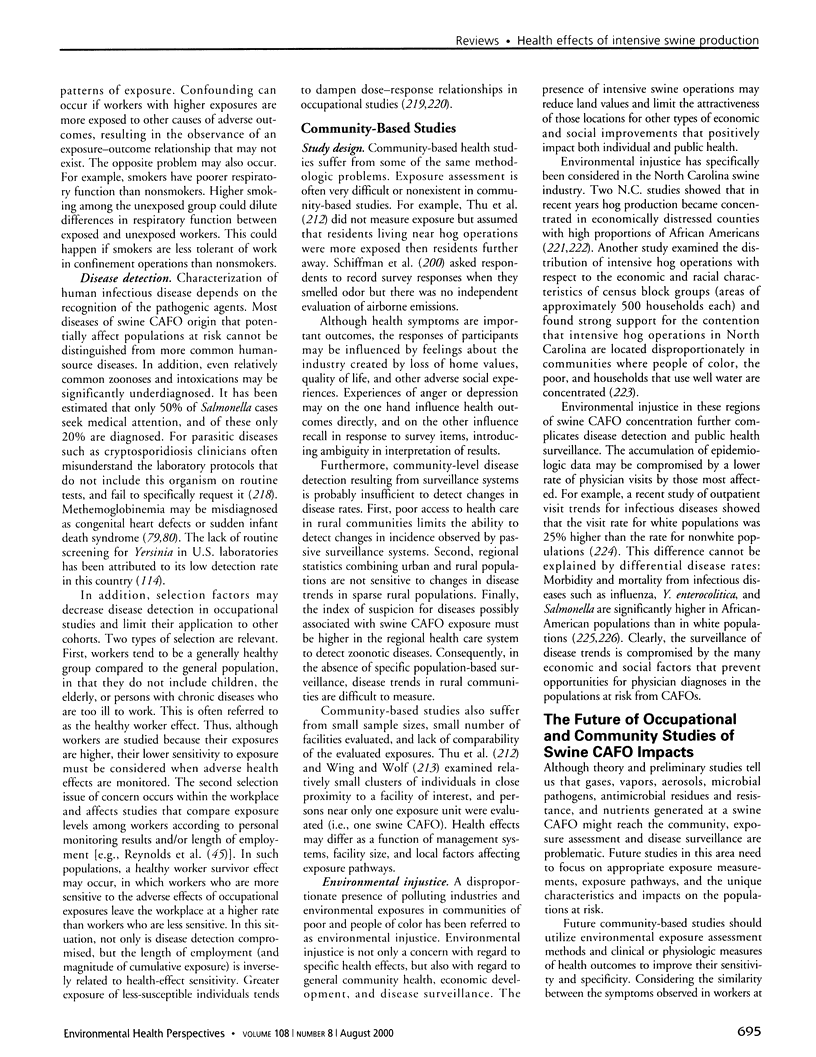
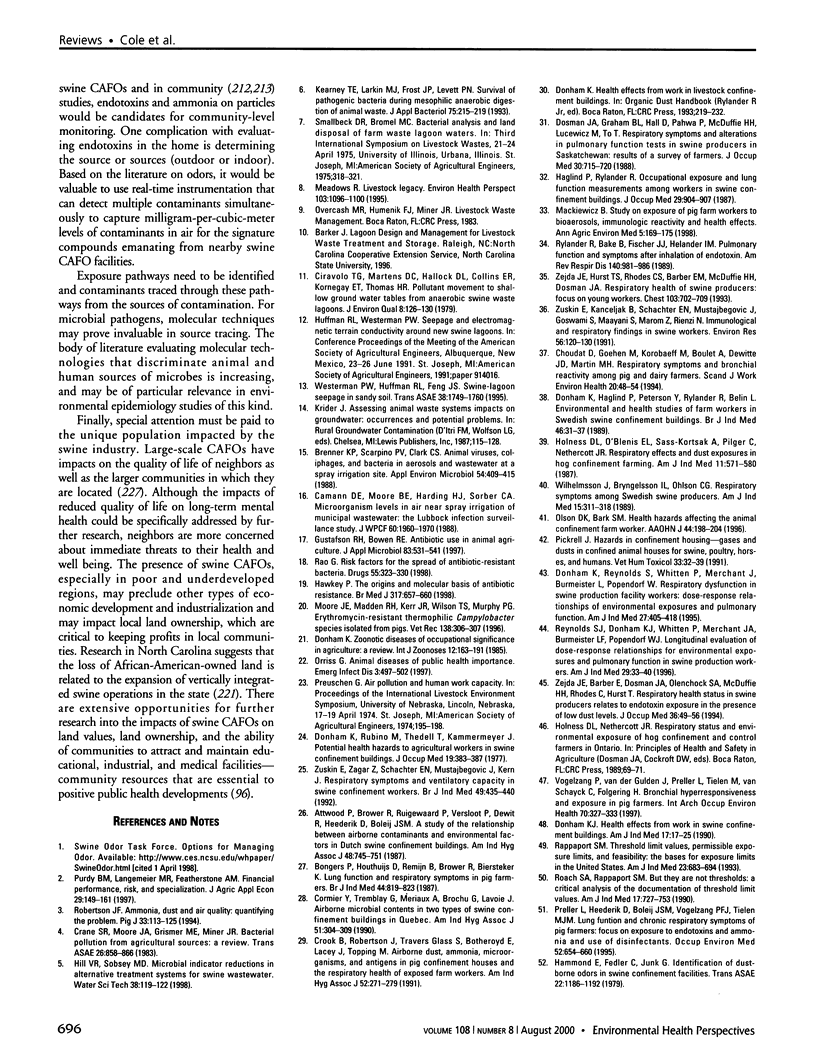
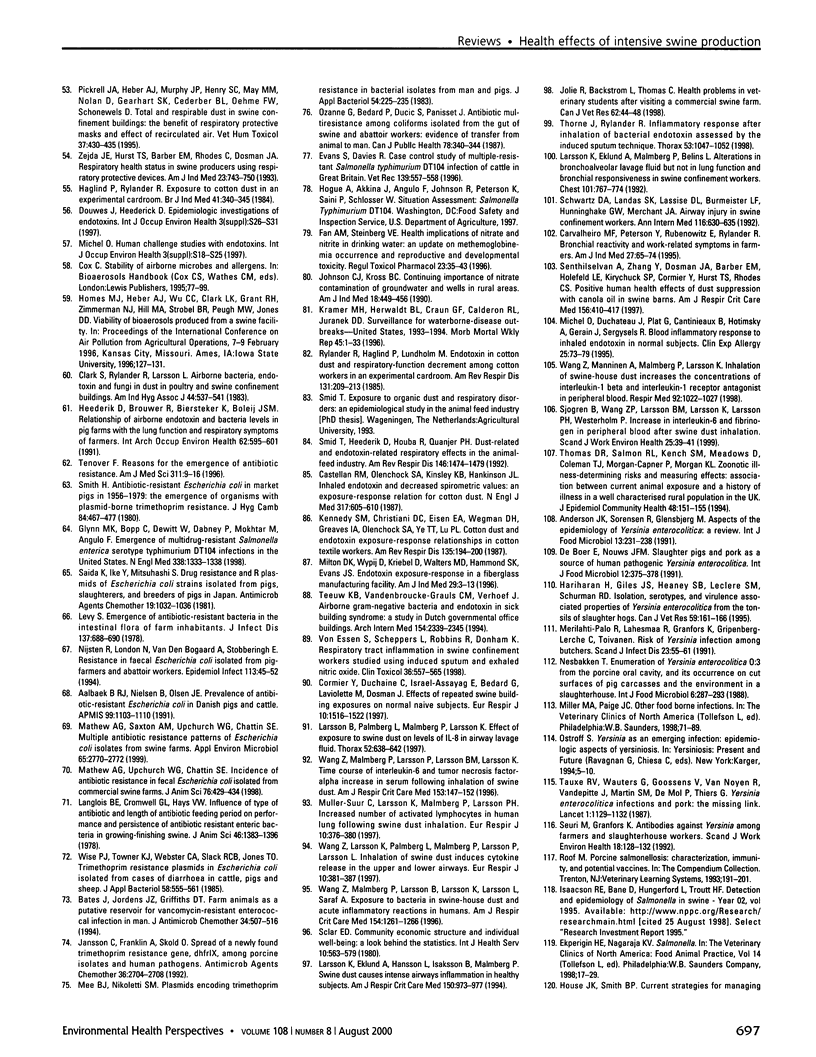
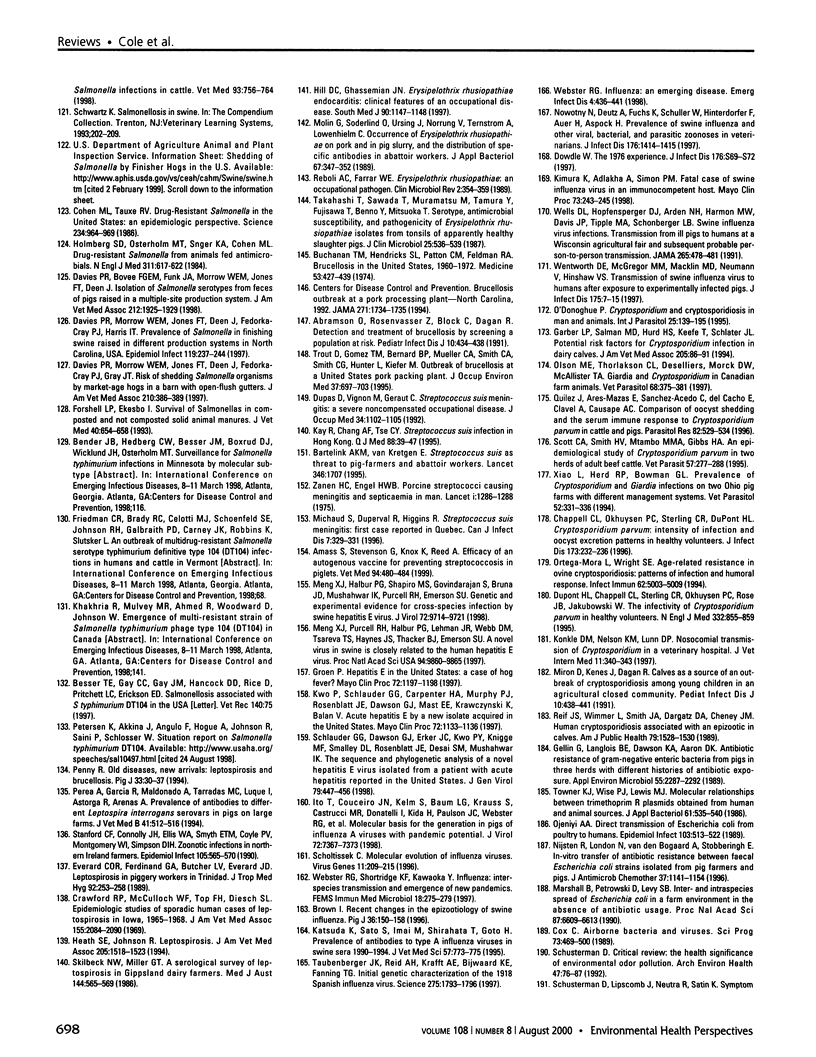
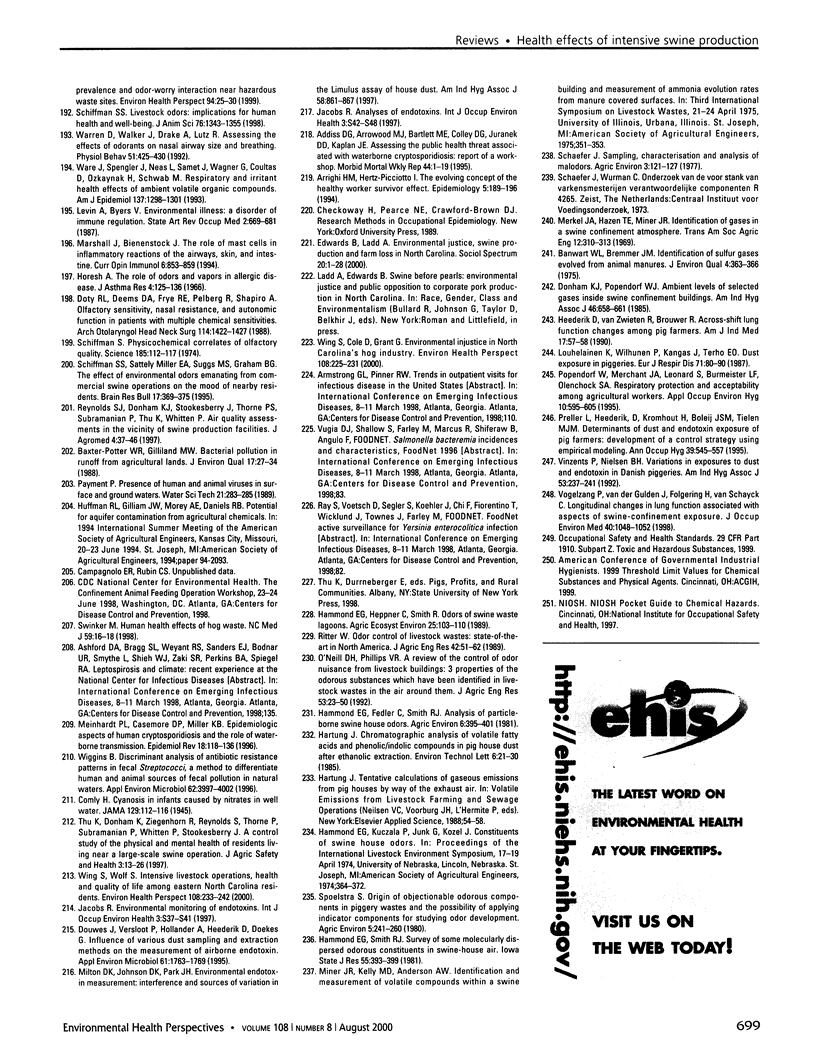
Selected References
These references are in PubMed. This may not be the complete list of references from this article.
- Aalbaek B., Rasmussen J., Nielsen B., Olsen J. E. Prevalence of antibiotic-resistant Escherichia coli in Danish pigs and cattle. APMIS. 1991 Dec;99(12):1103–1110. [PubMed] [Google Scholar]
- Abramson O., Rosenvasser Z., Block C., Dagan R. Detection and treatment of brucellosis by screening a population at risk. Pediatr Infect Dis J. 1991 Jun;10(6):434–438. doi: 10.1097/00006454-199106000-00003. [DOI] [PubMed] [Google Scholar]
- Andersen J. K., Sørensen R., Glensbjerg M. Aspects of the epidemiology of Yersinia enterocolitica: a review. Int J Food Microbiol. 1991 Jul;13(3):231–237. doi: 10.1016/0168-1605(91)90007-c. [DOI] [PubMed] [Google Scholar]
- Arrighi H. M., Hertz-Picciotto I. The evolving concept of the healthy worker survivor effect. Epidemiology. 1994 Mar;5(2):189–196. doi: 10.1097/00001648-199403000-00009. [DOI] [PubMed] [Google Scholar]
- Attwood P., Brouwer R., Ruigewaard P., Versloot P., de Wit R., Heederik D., Boleij J. S. A study of the relationship between airborne contaminants and environmental factors in Dutch swine confinement buildings. Am Ind Hyg Assoc J. 1987 Aug;48(8):745–751. doi: 10.1080/15298668791385507. [DOI] [PubMed] [Google Scholar]
- Bartelink A. K., van Kregten E. Streptococcus suis as threat to pig-farmers and abattoir workers. Lancet. 1995 Dec 23;346(8991-8992):1707–1707. doi: 10.1016/s0140-6736(95)92874-x. [DOI] [PubMed] [Google Scholar]
- Bates J., Jordens J. Z., Griffiths D. T. Farm animals as a putative reservoir for vancomycin-resistant enterococcal infection in man. J Antimicrob Chemother. 1994 Oct;34(4):507–514. doi: 10.1093/jac/34.4.507. [DOI] [PubMed] [Google Scholar]
- Besser T. E., Gay C. C., Gay J. M., Hancock D. D., Rice D., Pritchett L. C., Erickson E. D. Salmonellosis associated with S typhimurium DT104 in the USA. Vet Rec. 1997 Jan 18;140(3):75–75. [PubMed] [Google Scholar]
- Bongers P., Houthuijs D., Remijn B., Brouwer R., Biersteker K. Lung function and respiratory symptoms in pig farmers. Br J Ind Med. 1987 Dec;44(12):819–823. doi: 10.1136/oem.44.12.819. [DOI] [PMC free article] [PubMed] [Google Scholar]
- Brenner K. P., Scarpino P. V., Clark C. S. Animal viruses, coliphages, and bacteria in aerosols and wastewater at a spray irrigation site. Appl Environ Microbiol. 1988 Feb;54(2):409–415. doi: 10.1128/aem.54.2.409-415.1988. [DOI] [PMC free article] [PubMed] [Google Scholar]
- Buchanan T. M., Hendricks S. L., Patton C. M., Feldman R. A. Brucellosis in the United States, 1960-1972; An abattoir-associated disease. Part III. Epidemiology and evidence for acquired immunity. Medicine (Baltimore) 1974 Nov;53(6):427–439. [PubMed] [Google Scholar]
- Carvalheiro M. F., Peterson Y., Rubenowitz E., Rylander R. Bronchial reactivity and work-related symptoms in farmers. Am J Ind Med. 1995 Jan;27(1):65–74. doi: 10.1002/ajim.4700270107. [DOI] [PubMed] [Google Scholar]
- Castellan R. M., Olenchock S. A., Kinsley K. B., Hankinson J. L. Inhaled endotoxin and decreased spirometric values. An exposure-response relation for cotton dust. N Engl J Med. 1987 Sep 3;317(10):605–610. doi: 10.1056/NEJM198709033171005. [DOI] [PubMed] [Google Scholar]
- Chappell C. L., Okhuysen P. C., Sterling C. R., DuPont H. L. Cryptosporidium parvum: intensity of infection and oocyst excretion patterns in healthy volunteers. J Infect Dis. 1996 Jan;173(1):232–236. doi: 10.1093/infdis/173.1.232. [DOI] [PubMed] [Google Scholar]
- Choudat D., Goehen M., Korobaeff M., Boulet A., Dewitte J. D., Martin M. H. Respiratory symptoms and bronchial reactivity among pig and dairy farmers. Scand J Work Environ Health. 1994 Feb;20(1):48–54. doi: 10.5271/sjweh.1429. [DOI] [PubMed] [Google Scholar]
- Clark S., Rylander R., Larsson L. Airborne bacteria, endotoxin and fungi in dust in poultry and swine confinement buildings. Am Ind Hyg Assoc J. 1983 Jul;44(7):537–541. doi: 10.1080/15298668391405265. [DOI] [PubMed] [Google Scholar]
- Cohen M. L., Tauxe R. V. Drug-resistant Salmonella in the United States: an epidemiologic perspective. Science. 1986 Nov 21;234(4779):964–969. doi: 10.1126/science.3535069. [DOI] [PubMed] [Google Scholar]
- Cormier Y., Duchaine C., Israël-Assayag E., Bédard G., Laviolette M., Dosman J. Effects of repeated swine building exposures on normal naive subjects. Eur Respir J. 1997 Jul;10(7):1516–1522. doi: 10.1183/09031936.97.10071516. [DOI] [PubMed] [Google Scholar]
- Cormier Y., Tremblay G., Meriaux A., Brochu G., Lavoie J. Airborne microbial contents in two types of swine confinement buildings in Quebec. Am Ind Hyg Assoc J. 1990 Jun;51(6):304–309. doi: 10.1080/15298669091369709. [DOI] [PubMed] [Google Scholar]
- Cox C. S. Airborne bacteria and viruses. Sci Prog. 1989;73(292 Pt 4):469–499. [PubMed] [Google Scholar]
- Crawford R. P., McCulloch W. F., Top F. H., Sr, Diesch S. L. Epidemiologic studies of sporadic human cases of leptospirosis in Iowa, 1965-1968. J Am Vet Med Assoc. 1969 Dec 15;155(12):2084–2090. [PubMed] [Google Scholar]
- Crook B., Robertson J. F., Glass S. A., Botheroyd E. M., Lacey J., Topping M. D. Airborne dust, ammonia, microorganisms, and antigens in pig confinement houses and the respiratory health of exposed farm workers. Am Ind Hyg Assoc J. 1991 Jul;52(7):271–279. doi: 10.1080/15298669191364721. [DOI] [PubMed] [Google Scholar]
- Davies P. R., Bovee F. G., Funk J. A., Morrow W. E., Jones F. T., Deen J. Isolation of Salmonella serotypes from feces of pigs raised in a multiple-site production system. J Am Vet Med Assoc. 1998 Jun 15;212(12):1925–1929. [PubMed] [Google Scholar]
- Davies P. R., Morrow W. E., Jones F. T., Deen J., Fedorka-Cray P. J., Gray J. T. Risk of shedding Salmonella organisms by market-age hogs in a barn with open-flush gutters. J Am Vet Med Assoc. 1997 Feb 1;210(3):386–389. [PubMed] [Google Scholar]
- Davies P. R., Morrow W. E., Jones F. T., Deen J., Fedorka-Cray P. J., Harris I. T. Prevalence of Salmonella in finishing swine raised in different production systems in North Carolina, USA. Epidemiol Infect. 1997 Oct;119(2):237–244. doi: 10.1017/s095026889700784x. [DOI] [PMC free article] [PubMed] [Google Scholar]
- Donham K. J. Health effects from work in swine confinement buildings. Am J Ind Med. 1990;17(1):17–25. doi: 10.1002/ajim.4700170105. [DOI] [PubMed] [Google Scholar]
- Donham K. J., Popendorf W. J. Ambient levels of selected gases inside swine confinement buildings. Am Ind Hyg Assoc J. 1985 Nov;46(11):658–661. doi: 10.1080/15298668591395490. [DOI] [PubMed] [Google Scholar]
- Donham K. J., Reynolds S. J., Whitten P., Merchant J. A., Burmeister L., Popendorf W. J. Respiratory dysfunction in swine production facility workers: dose-response relationships of environmental exposures and pulmonary function. Am J Ind Med. 1995 Mar;27(3):405–418. doi: 10.1002/ajim.4700270309. [DOI] [PubMed] [Google Scholar]
- Donham K. J., Rubino M., Thedell T. D., Kammermeyer J. Potential health hazards to agricultural workers in swine confinement buildings. J Occup Med. 1977 Jun;19(6):383–387. doi: 10.1097/00043764-197706000-00004. [DOI] [PubMed] [Google Scholar]
- Donham K. J. Zoonotic disease of occupational significance in agriculture: a review. Int J Zoonoses. 1985 Sep;12(3):163–191. [PubMed] [Google Scholar]
- Donham K., Haglind P., Peterson Y., Rylander R., Belin L. Environmental and health studies of farm workers in Swedish swine confinement buildings. Br J Ind Med. 1989 Jan;46(1):31–37. doi: 10.1136/oem.46.1.31. [DOI] [PMC free article] [PubMed] [Google Scholar]
- Dosman J. A., Graham B. L., Hall D., Pahwa P., McDuffie H. H., Lucewicz M., To T. Respiratory symptoms and alterations in pulmonary function tests in swine producers in Saskatchewan: results of a survey of farmers. J Occup Med. 1988 Sep;30(9):715–720. [PubMed] [Google Scholar]
- Doty R. L., Deems D. A., Frye R. E., Pelberg R., Shapiro A. Olfactory sensitivity, nasal resistance, and autonomic function in patients with multiple chemical sensitivities. Arch Otolaryngol Head Neck Surg. 1988 Dec;114(12):1422–1427. doi: 10.1001/archotol.1988.01860240072027. [DOI] [PubMed] [Google Scholar]
- Douwes J., Versloot P., Hollander A., Heederik D., Doekes G. Influence of various dust sampling and extraction methods on the measurement of airborne endotoxin. Appl Environ Microbiol. 1995 May;61(5):1763–1769. doi: 10.1128/aem.61.5.1763-1769.1995. [DOI] [PMC free article] [PubMed] [Google Scholar]
- Dowdle W. R. Pandemic influenza: confronting a re-emergent threat. The 1976 experience. J Infect Dis. 1997 Aug;176 (Suppl 1):S69–S72. doi: 10.1086/514180. [DOI] [PubMed] [Google Scholar]
- DuPont H. L., Chappell C. L., Sterling C. R., Okhuysen P. C., Rose J. B., Jakubowski W. The infectivity of Cryptosporidium parvum in healthy volunteers. N Engl J Med. 1995 Mar 30;332(13):855–859. doi: 10.1056/NEJM199503303321304. [DOI] [PubMed] [Google Scholar]
- Dupas D., Vignon M., Géraut C. Streptococcus suis meningitis. A severe noncompensated occupational disease. J Occup Med. 1992 Nov;34(11):1102–1105. [PubMed] [Google Scholar]
- Ekperigin H. E., Nagaraja K. V. Microbial food borne pathogens. Salmonella. Vet Clin North Am Food Anim Pract. 1998 Mar;14(1):17–29. [PubMed] [Google Scholar]
- Evans S., Davies R. Case control study of multiple-resistant Salmonella typhimurium DT104 infection of cattle in Great Britain. Vet Rec. 1996 Dec 7;139(23):557–558. [PubMed] [Google Scholar]
- Everard C. O., Ferdinand G. A., Butcher L. V., Everard J. D. Leptospirosis in piggery workers on Trinidad. J Trop Med Hyg. 1989 Aug;92(4):253–258. [PubMed] [Google Scholar]
- Fan A. M., Steinberg V. E. Health implications of nitrate and nitrite in drinking water: an update on methemoglobinemia occurrence and reproductive and developmental toxicity. Regul Toxicol Pharmacol. 1996 Feb;23(1 Pt 1):35–43. doi: 10.1006/rtph.1996.0006. [DOI] [PubMed] [Google Scholar]
- Forshell L. P., Ekesbo I. Survival of Salmonellas in composted and not composted solid animal manure. Zentralbl Veterinarmed B. 1993 Dec;40(9-10):654–658. doi: 10.1111/j.1439-0450.1993.tb00188.x. [DOI] [PubMed] [Google Scholar]
- Garber L. P., Salman M. D., Hurd H. S., Keefe T., Schlater J. L. Potential risk factors for Cryptosporidium infection in dairy calves. J Am Vet Med Assoc. 1994 Jul 1;205(1):86–91. [PubMed] [Google Scholar]
- Gellin G., Langlois B. E., Dawson K. A., Aaron D. K. Antibiotic resistance of gram-negative enteric bacteria from pigs in three herds with different histories of antibiotic exposure. Appl Environ Microbiol. 1989 Sep;55(9):2287–2292. doi: 10.1128/aem.55.9.2287-2292.1989. [DOI] [PMC free article] [PubMed] [Google Scholar]
- Glynn M. K., Bopp C., Dewitt W., Dabney P., Mokhtar M., Angulo F. J. Emergence of multidrug-resistant Salmonella enterica serotype typhimurium DT104 infections in the United States. N Engl J Med. 1998 May 7;338(19):1333–1338. doi: 10.1056/NEJM199805073381901. [DOI] [PubMed] [Google Scholar]
- Gustafson R. H., Bowen R. E. Antibiotic use in animal agriculture. J Appl Microbiol. 1997 Nov;83(5):531–541. doi: 10.1046/j.1365-2672.1997.00280.x. [DOI] [PubMed] [Google Scholar]
- Haglind P., Rylander R. Exposure to cotton dust in an experimental cardroom. Br J Ind Med. 1984 Aug;41(3):340–345. doi: 10.1136/oem.41.3.340. [DOI] [PMC free article] [PubMed] [Google Scholar]
- Haglind P., Rylander R. Occupational exposure and lung function measurements among workers in swine confinement buildings. J Occup Med. 1987 Nov;29(11):904–907. [PubMed] [Google Scholar]
- Hariharan H., Giles J. S., Heaney S. B., Leclerc S. M., Schurman R. D. Isolation, serotypes, and virulence-associated properties of Yersinia enterocolitica from the tonsils of slaughter hogs. Can J Vet Res. 1995 Jul;59(3):161–166. [PMC free article] [PubMed] [Google Scholar]
- Hawkey P. M. The origins and molecular basis of antibiotic resistance. BMJ. 1998 Sep 5;317(7159):657–660. doi: 10.1136/bmj.317.7159.657. [DOI] [PMC free article] [PubMed] [Google Scholar]
- Heath S. E., Johnson R. Leptospirosis. J Am Vet Med Assoc. 1994 Dec 1;205(11):1518–1523. [PubMed] [Google Scholar]
- Heederik D., Brouwer R., Biersteker K., Boleij J. S. Relationship of airborne endotoxin and bacteria levels in pig farms with the lung function and respiratory symptoms of farmers. Int Arch Occup Environ Health. 1991;62(8):595–601. doi: 10.1007/BF00381114. [DOI] [PubMed] [Google Scholar]
- Heederik D., van Zwieten R., Brouwer R. Across-shift lung function changes among pig farmers. Am J Ind Med. 1990;17(1):57–58. doi: 10.1002/ajim.4700170110. [DOI] [PubMed] [Google Scholar]
- Hill D. C., Ghassemian J. N. Erysipelothrix rhusiopathiae endocarditis: clinical features of an occupational disease. South Med J. 1997 Nov;90(11):1147–1148. [PubMed] [Google Scholar]
- Holmberg S. D., Osterholm M. T., Senger K. A., Cohen M. L. Drug-resistant Salmonella from animals fed antimicrobials. N Engl J Med. 1984 Sep 6;311(10):617–622. doi: 10.1056/NEJM198409063111001. [DOI] [PubMed] [Google Scholar]
- Holness D. L., O'Blenis E. L., Sass-Kortsak A., Pilger C., Nethercott J. R. Respiratory effects and dust exposures in hog confinement farming. Am J Ind Med. 1987;11(5):571–580. doi: 10.1002/ajim.4700110509. [DOI] [PubMed] [Google Scholar]
- Horesh A. J. The role of odors and vapors in allergic disease. J Asthma Res. 1966 Dec;4(2):125–136. doi: 10.3109/02770906609100533. [DOI] [PubMed] [Google Scholar]
- Ito T., Couceiro J. N., Kelm S., Baum L. G., Krauss S., Castrucci M. R., Donatelli I., Kida H., Paulson J. C., Webster R. G. Molecular basis for the generation in pigs of influenza A viruses with pandemic potential. J Virol. 1998 Sep;72(9):7367–7373. doi: 10.1128/jvi.72.9.7367-7373.1998. [DOI] [PMC free article] [PubMed] [Google Scholar]
- Jansson C., Franklin A., Sköld O. Spread of a newly found trimethoprim resistance gene, dhfrIX, among porcine isolates and human pathogens. Antimicrob Agents Chemother. 1992 Dec;36(12):2704–2708. doi: 10.1128/aac.36.12.2704. [DOI] [PMC free article] [PubMed] [Google Scholar]
- Johnson C. J., Kross B. C. Continuing importance of nitrate contamination of groundwater and wells in rural areas. Am J Ind Med. 1990;18(4):449–456. doi: 10.1002/ajim.4700180416. [DOI] [PubMed] [Google Scholar]
- Jolie R., Bäckström L., Thomas C. Health problems in veterinary students after visiting a commercial swine farm. Can J Vet Res. 1998 Jan;62(1):44–48. [PMC free article] [PubMed] [Google Scholar]
- Katsuda K., Sato S., Imai M., Shirahata T., Goto H. Prevalence of antibodies to type A influenza viruses in swine sera 1990-1994. J Vet Med Sci. 1995 Aug;57(4):773–775. doi: 10.1292/jvms.57.773. [DOI] [PubMed] [Google Scholar]
- Kay R., Cheng A. F., Tse C. Y. Streptococcus suis infection in Hong Kong. QJM. 1995 Jan;88(1):39–47. [PubMed] [Google Scholar]
- Kearney T. E., Larkin M. J., Frost J. P., Levett P. N. Survival of pathogenic bacteria during mesophilic anaerobic digestion of animal waste. J Appl Bacteriol. 1993 Sep;75(3):215–219. doi: 10.1111/j.1365-2672.1993.tb02768.x. [DOI] [PubMed] [Google Scholar]
- Kennedy S. M., Christiani D. C., Eisen E. A., Wegman D. H., Greaves I. A., Olenchock S. A., Ye T. T., Lu P. L. Cotton dust and endotoxin exposure-response relationships in cotton textile workers. Am Rev Respir Dis. 1987 Jan;135(1):194–200. doi: 10.1164/arrd.1987.135.1.194. [DOI] [PubMed] [Google Scholar]
- Kimura K., Adlakha A., Simon P. M. Fatal case of swine influenza virus in an immunocompetent host. Mayo Clin Proc. 1998 Mar;73(3):243–245. doi: 10.4065/73.3.243. [DOI] [PubMed] [Google Scholar]
- Konkle D. M., Nelson K. M., Lunn D. P. Nosocomial transmission of Cryptosporidium in a veterinary hospital. J Vet Intern Med. 1997 Nov-Dec;11(6):340–343. doi: 10.1111/j.1939-1676.1997.tb00477.x. [DOI] [PubMed] [Google Scholar]
- Kramer M. H., Herwaldt B. L., Craun G. F., Calderon R. L., Juranek D. D. Surveillance for waterborne-disease outbreaks--United States, 1993-1994. MMWR CDC Surveill Summ. 1996 Apr 12;45(1):1–33. [PubMed] [Google Scholar]
- Kwo P. Y., Schlauder G. G., Carpenter H. A., Murphy P. J., Rosenblatt J. E., Dawson G. J., Mast E. E., Krawczynski K., Balan V. Acute hepatitis E by a new isolate acquired in the United States. Mayo Clin Proc. 1997 Dec;72(12):1133–1136. doi: 10.4065/72.12.1133. [DOI] [PubMed] [Google Scholar]
- Langlois B. E., Cromwell G. L., Hays V. W. Influence of type of antibiotic and length of antibiotic feeding period on performance and persistence of antibiotic resistant enteric bacteria in growing-finishing swine. J Anim Sci. 1978 May;46(5):1383–1396. doi: 10.2527/jas1978.4651383x. [DOI] [PubMed] [Google Scholar]
- Larsson B. M., Palmberg L., Malmberg P. O., Larsson K. Effect of exposure to swine dust on levels of IL-8 in airway lavage fluid. Thorax. 1997 Jul;52(7):638–642. doi: 10.1136/thx.52.7.638. [DOI] [PMC free article] [PubMed] [Google Scholar]
- Larsson K. A., Eklund A. G., Hansson L. O., Isaksson B. M., Malmberg P. O. Swine dust causes intense airways inflammation in healthy subjects. Am J Respir Crit Care Med. 1994 Oct;150(4):973–977. doi: 10.1164/ajrccm.150.4.7921472. [DOI] [PubMed] [Google Scholar]
- Larsson K., Eklund A., Malmberg P., Belin L. Alterations in bronchoalveolar lavage fluid but not in lung function and bronchial responsiveness in swine confinement workers. Chest. 1992 Mar;101(3):767–774. doi: 10.1378/chest.101.3.767. [DOI] [PubMed] [Google Scholar]
- Levin A. S., Byers V. S. Environmental illness: a disorder of immune regulation. Occup Med. 1987 Oct-Dec;2(4):669–681. [PubMed] [Google Scholar]
- Levy S. B. Emergence of antibiotic-resistant bacteria in the intestinal flora of farm inhabitants. J Infect Dis. 1978 May;137(5):689–690. [PubMed] [Google Scholar]
- Louhelainen K., Vilhunen P., Kangas J., Terho E. O. Dust exposure in piggeries. Eur J Respir Dis Suppl. 1987;152:80–90. [PubMed] [Google Scholar]
- Mackiewicz B. Study on exposure of pig farm workers to bioaerosols, immunologic reactivity and health effects. Ann Agric Environ Med. 1998;5(2):169–175. [PubMed] [Google Scholar]
- Marshall B., Petrowski D., Levy S. B. Inter- and intraspecies spread of Escherichia coli in a farm environment in the absence of antibiotic usage. Proc Natl Acad Sci U S A. 1990 Sep;87(17):6609–6613. doi: 10.1073/pnas.87.17.6609. [DOI] [PMC free article] [PubMed] [Google Scholar]
- Marshall J. S., Bienenstock J. The role of mast cells in inflammatory reactions of the airways, skin and intestine. Curr Opin Immunol. 1994 Dec;6(6):853–859. doi: 10.1016/0952-7915(94)90004-3. [DOI] [PubMed] [Google Scholar]
- Mathew A. G., Saxton A. M., Upchurch W. G., Chattin S. E. Multiple antibiotic resistance patterns of Escherichia coli isolates from swine farms. Appl Environ Microbiol. 1999 Jun;65(6):2770–2772. doi: 10.1128/aem.65.6.2770-2772.1999. [DOI] [PMC free article] [PubMed] [Google Scholar]
- Mathew A. G., Upchurch W. G., Chattin S. E. Incidence of antibiotic resistance in fecal Escherichia coli isolated from commercial swine farms. J Anim Sci. 1998 Feb;76(2):429–434. doi: 10.2527/1998.762429x. [DOI] [PubMed] [Google Scholar]
- Meadows R. Livestock legacy. Environ Health Perspect. 1995 Dec;103(12):1096–1100. doi: 10.1289/ehp.951031096. [DOI] [PMC free article] [PubMed] [Google Scholar]
- Mee B. J., Nikoletti S. M. Plasmids encoding trimethoprim resistance in bacterial isolates from man and pigs. J Appl Bacteriol. 1983 Apr;54(2):225–235. doi: 10.1111/j.1365-2672.1983.tb02611.x. [DOI] [PubMed] [Google Scholar]
- Meinhardt P. L., Casemore D. P., Miller K. B. Epidemiologic aspects of human cryptosporidiosis and the role of waterborne transmission. Epidemiol Rev. 1996;18(2):118–136. doi: 10.1093/oxfordjournals.epirev.a017920. [DOI] [PubMed] [Google Scholar]
- Meng X. J., Halbur P. G., Shapiro M. S., Govindarajan S., Bruna J. D., Mushahwar I. K., Purcell R. H., Emerson S. U. Genetic and experimental evidence for cross-species infection by swine hepatitis E virus. J Virol. 1998 Dec;72(12):9714–9721. doi: 10.1128/jvi.72.12.9714-9721.1998. [DOI] [PMC free article] [PubMed] [Google Scholar]
- Meng X. J., Purcell R. H., Halbur P. G., Lehman J. R., Webb D. M., Tsareva T. S., Haynes J. S., Thacker B. J., Emerson S. U. A novel virus in swine is closely related to the human hepatitis E virus. Proc Natl Acad Sci U S A. 1997 Sep 2;94(18):9860–9865. doi: 10.1073/pnas.94.18.9860. [DOI] [PMC free article] [PubMed] [Google Scholar]
- Merilahti-Palo R., Lahesmaa R., Granfors K., Gripenberg-Lerche C., Toivanen P. Risk of Yersinia infection among butchers. Scand J Infect Dis. 1991;23(1):55–61. doi: 10.3109/00365549109023375. [DOI] [PubMed] [Google Scholar]
- Michel O., Duchateau J., Plat G., Cantinieaux B., Hotimsky A., Gerain J., Sergysels R. Blood inflammatory response to inhaled endotoxin in normal subjects. Clin Exp Allergy. 1995 Jan;25(1):73–79. doi: 10.1111/j.1365-2222.1995.tb01005.x. [DOI] [PubMed] [Google Scholar]
- Milton D. K., Johnson D. K., Park J. H. Environmental endotoxin measurement: interference and sources of variation in the Limulus assay of house dust. Am Ind Hyg Assoc J. 1997 Dec;58(12):861–867. doi: 10.1080/15428119791012199. [DOI] [PubMed] [Google Scholar]
- Milton D. K., Wypij D., Kriebel D., Walters M. D., Hammond S. K., Evans J. S. Endotoxin exposure-response in a fiberglass manufacturing facility. Am J Ind Med. 1996 Jan;29(1):3–13. doi: 10.1002/(SICI)1097-0274(199601)29:1<3::AID-AJIM2>3.0.CO;2-V. [DOI] [PubMed] [Google Scholar]
- Miron D., Kenes J., Dagan R. Calves as a source of an outbreak of cryptosporidiosis among young children in an agricultural closed community. Pediatr Infect Dis J. 1991 Jun;10(6):438–441. doi: 10.1097/00006454-199106000-00004. [DOI] [PubMed] [Google Scholar]
- Molin G., Söderlind O., Ursing J., Nørrung V., Ternström A., Löwenhielm C. Occurrence of Erysipelothrix rhusiopathiae on pork and in pig slurry, and the distribution of specific antibodies in abattoir workers. J Appl Bacteriol. 1989 Oct;67(4):347–352. doi: 10.1111/j.1365-2672.1989.tb02504.x. [DOI] [PubMed] [Google Scholar]
- Moore J. E., Madden R. H., Kerr J. R., Wilson T. S., Murphy P. G. Erythromycin-resistant thermophilic Campylobacter species isolated from pigs. Vet Rec. 1996 Mar 30;138(13):306–307. doi: 10.1136/vr.138.13.306. [DOI] [PubMed] [Google Scholar]
- Müller-Suur C., Larsson K., Malmberg P., Larsson P. H. Increased number of activated lymphocytes in human lung following swine dust inhalation. Eur Respir J. 1997 Feb;10(2):376–380. doi: 10.1183/09031936.97.10020376. [DOI] [PubMed] [Google Scholar]
- Nesbakken T. Enumeration of Yersinia enterocolitica O:3 from the porcine oral cavity, and its occurrence on cut surfaces of pig carcasses and the environment in a slaughterhouse. Int J Food Microbiol. 1988 Jun;6(4):287–293. doi: 10.1016/0168-1605(88)90022-0. [DOI] [PubMed] [Google Scholar]
- Nijsten R., London N., van den Bogaard A., Stobberingh E. In-vitro transfer of antibiotic resistance between faecal Escherichia coli strains isolated from pig farmers and pigs. J Antimicrob Chemother. 1996 Jun;37(6):1141–1154. doi: 10.1093/jac/37.6.1141. [DOI] [PubMed] [Google Scholar]
- Nijsten R., London N., van den Bogaard A., Stobberingh E. Resistance in faecal Escherichia coli isolated from pigfarmers and abattoir workers. Epidemiol Infect. 1994 Aug;113(1):45–52. doi: 10.1017/s0950268800051451. [DOI] [PMC free article] [PubMed] [Google Scholar]
- Nowotny N., Deutz A., Fuchs K., Schuller W., Hinterdorfer F., Auer H., Aspöck H. Prevalence of swine influenza and other viral, bacterial, and parasitic zoonoses in veterinarians. J Infect Dis. 1997 Nov;176(5):1414–1415. doi: 10.1086/517337. [DOI] [PubMed] [Google Scholar]
- O'Donoghue P. J. Cryptosporidium and cryptosporidiosis in man and animals. Int J Parasitol. 1995 Feb;25(2):139–195. doi: 10.1016/0020-7519(94)e0059-v. [DOI] [PubMed] [Google Scholar]
- Ojeniyi A. A. Direct transmission of Escherichia coli from poultry to humans. Epidemiol Infect. 1989 Dec;103(3):513–522. doi: 10.1017/s0950268800030910. [DOI] [PMC free article] [PubMed] [Google Scholar]
- Olson D. K., Bark S. M. Health hazards affecting the animal confinement farm worker. AAOHN J. 1996 Apr;44(4):198–206. [PubMed] [Google Scholar]
- Olson M. E., Thorlakson C. L., Deselliers L., Morck D. W., McAllister T. A. Giardia and Cryptosporidium in Canadian farm animals. Vet Parasitol. 1997 Mar;68(4):375–381. doi: 10.1016/s0304-4017(96)01072-2. [DOI] [PubMed] [Google Scholar]
- Orriss G. D. Animal diseases of public health importance. Emerg Infect Dis. 1997 Oct-Dec;3(4):497–502. doi: 10.3201/eid0304.970413. [DOI] [PMC free article] [PubMed] [Google Scholar]
- Ortegà-Mora L. M., Wright S. E. Age-related resistance in ovine cryptosporidiosis: patterns of infection and humoral immune response. Infect Immun. 1994 Nov;62(11):5003–5009. doi: 10.1128/iai.62.11.5003-5009.1994. [DOI] [PMC free article] [PubMed] [Google Scholar]
- Ozanne G., Bédard P., Ducic S., Panisset J. C. Antibiotic multiresistance among coliforms isolated from the gut of swine and abattoir workers: evidence of transfer from animal to man. Can J Public Health. 1987 Sep-Oct;78(5):340–344. [PubMed] [Google Scholar]
- Perea A., Garcia R., Maldonado A., Tarradas M. C., Luque I., Astorga R., Arenas A. Prevalence of antibodies to different Leptospira interrogans serovars in pigs on large farms. Zentralbl Veterinarmed B. 1994 Oct;41(7-8):512–516. doi: 10.1111/j.1439-0450.1994.tb00257.x. [DOI] [PubMed] [Google Scholar]
- Pickrell J. A., Heber A. J., Murphy J. P., Henry S. C., May M. M., Nolan D., Gearhart S. K., Cederberg B. L., Oehme F. W., Schoneweis D. Total and respirable dust in swine confinement buildings: the benefit of respiratory protective masks and effect of recirculated air. Vet Hum Toxicol. 1995 Oct;37(5):430–435. [PubMed] [Google Scholar]
- Pickrell J. Hazards in confinement housing--gases and dusts in confined animal houses for swine, poultry, horses and humans. Vet Hum Toxicol. 1991 Feb;33(1):32–39. [PubMed] [Google Scholar]
- Porcine streptococci causing meningitis and septicaemia in man. Lancet. 1975 Jun 7;1(7919):1286–1288. [PubMed] [Google Scholar]
- Preller L., Heederik D., Boleij J. S., Vogelzang P. F., Tielen M. J. Lung function and chronic respiratory symptoms of pig farmers: focus on exposure to endotoxins and ammonia and use of disinfectants. Occup Environ Med. 1995 Oct;52(10):654–660. doi: 10.1136/oem.52.10.654. [DOI] [PMC free article] [PubMed] [Google Scholar]
- Preller L., Heederik D., Kromhout H., Boleij J. S., Tielen M. J. Determinants of dust and endotoxin exposure of pig farmers: development of a control strategy using empirical modelling. Ann Occup Hyg. 1995 Oct;39(5):545–557. [PubMed] [Google Scholar]
- Quílez J., Ares-Mazás E., Sánchez-Acedo C., del Cacho E., Clavel A., Causapé A. C. Comparison of oocyst shedding and the serum immune response to Cryptosporidium parvum in cattle and pigs. Parasitol Res. 1996;82(6):529–534. doi: 10.1007/s004360050157. [DOI] [PubMed] [Google Scholar]
- Rao G. G. Risk factors for the spread of antibiotic-resistant bacteria. Drugs. 1998 Mar;55(3):323–330. doi: 10.2165/00003495-199855030-00001. [DOI] [PubMed] [Google Scholar]
- Rappaport S. M. Threshold limit values, permissible exposure limits, and feasibility: the bases for exposure limits in the United States. Am J Ind Med. 1993 May;23(5):683–694. doi: 10.1002/ajim.4700230502. [DOI] [PubMed] [Google Scholar]
- Reboli A. C., Farrar W. E. Erysipelothrix rhusiopathiae: an occupational pathogen. Clin Microbiol Rev. 1989 Oct;2(4):354–359. doi: 10.1128/cmr.2.4.354. [DOI] [PMC free article] [PubMed] [Google Scholar]
- Reif J. S., Wimmer L., Smith J. A., Dargatz D. A., Cheney J. M. Human cryptosporidiosis associated with an epizootic in calves. Am J Public Health. 1989 Nov;79(11):1528–1530. doi: 10.2105/ajph.79.11.1528. [DOI] [PMC free article] [PubMed] [Google Scholar]
- Reynolds S. J., Donham K. J., Whitten P., Merchant J. A., Burmeister L. F., Popendorf W. J. Longitudinal evaluation of dose-response relationships for environmental exposures and pulmonary function in swine production workers. Am J Ind Med. 1996 Jan;29(1):33–40. doi: 10.1002/(SICI)1097-0274(199601)29:1<33::AID-AJIM5>3.0.CO;2-#. [DOI] [PubMed] [Google Scholar]
- Roach S. A., Rappaport S. M. But they are not thresholds: a critical analysis of the documentation of Threshold Limit Values. Am J Ind Med. 1990;17(6):727–753. doi: 10.1002/ajim.4700170607. [DOI] [PubMed] [Google Scholar]
- Rylander R., Bake B., Fischer J. J., Helander I. M. Pulmonary function and symptoms after inhalation of endotoxin. Am Rev Respir Dis. 1989 Oct;140(4):981–986. doi: 10.1164/ajrccm/140.4.981. [DOI] [PubMed] [Google Scholar]
- Rylander R., Haglind P., Lundholm M. Endotoxin in cotton dust and respiratory function decrement among cotton workers in an experimental cardroom. Am Rev Respir Dis. 1985 Feb;131(2):209–213. doi: 10.1164/arrd.1985.131.2.209. [DOI] [PubMed] [Google Scholar]
- Saida K., Ike Y., Mitsuhashi S. Drug resistance and R plasmids of Escherichia coli strains isolated from pigs, slaughterers, and breeders of pigs in Japan. Antimicrob Agents Chemother. 1981 Jun;19(6):1032–1036. doi: 10.1128/aac.19.6.1032. [DOI] [PMC free article] [PubMed] [Google Scholar]
- Schiffman S. S. Livestock odors: implications for human health and well-being. J Anim Sci. 1998 May;76(5):1343–1355. doi: 10.2527/1998.7651343x. [DOI] [PubMed] [Google Scholar]
- Schiffman S. S., Miller E. A., Suggs M. S., Graham B. G. The effect of environmental odors emanating from commercial swine operations on the mood of nearby residents. Brain Res Bull. 1995;37(4):369–375. doi: 10.1016/0361-9230(95)00015-1. [DOI] [PubMed] [Google Scholar]
- Schiffman S. S. Physicochemical correlates of olfactory quality. Science. 1974 Jul 12;185(4146):112–117. doi: 10.1126/science.185.4146.112. [DOI] [PubMed] [Google Scholar]
- Schlauder G. G., Dawson G. J., Erker J. C., Kwo P. Y., Knigge M. F., Smalley D. L., Rosenblatt J. E., Desai S. M., Mushahwar I. K. The sequence and phylogenetic analysis of a novel hepatitis E virus isolated from a patient with acute hepatitis reported in the United States. J Gen Virol. 1998 Mar;79(Pt 3):447–456. doi: 10.1099/0022-1317-79-3-447. [DOI] [PubMed] [Google Scholar]
- Scholtissek C. Molecular evolution of influenza viruses. Virus Genes. 1995;11(2-3):209–215. doi: 10.1007/BF01728660. [DOI] [PubMed] [Google Scholar]
- Schwartz D. A., Landas S. K., Lassise D. L., Burmeister L. F., Hunninghake G. W., Merchant J. A. Airway injury in swine confinement workers. Ann Intern Med. 1992 Apr 15;116(8):630–635. doi: 10.7326/0003-4819-116-8-630. [DOI] [PubMed] [Google Scholar]
- Sclar E. D. Community economic structure and individual well-being: a look behind the statistics. Int J Health Serv. 1980;10(4):563–579. doi: 10.2190/1K7N-N25A-BMJ7-PWAX. [DOI] [PubMed] [Google Scholar]
- Scott C. A., Smith H. V., Mtambo M. M., Gibbs H. A. An epidemiological study of Cryptosporidium parvum in two herds of adult beef cattle. Vet Parasitol. 1995 Apr;57(4):277–288. doi: 10.1016/0304-4017(94)00694-8. [DOI] [PubMed] [Google Scholar]
- Senthilselvan A., Zhang Y., Dosman J. A., Barber E. M., Holfeld L. E., Kirychuk S. P., Cormier Y., Hurst T. S., Rhodes C. S. Positive human health effects of dust suppression with canola oil in swine barns. Am J Respir Crit Care Med. 1997 Aug;156(2 Pt 1):410–417. doi: 10.1164/ajrccm.156.2.9612069. [DOI] [PubMed] [Google Scholar]
- Seuri M., Granfors K. Antibodies against Yersinia among farmers and slaughterhouse workers. Scand J Work Environ Health. 1992 Apr;18(2):128–132. doi: 10.5271/sjweh.1600. [DOI] [PubMed] [Google Scholar]
- Shusterman D. Critical review: the health significance of environmental odor pollution. Arch Environ Health. 1992 Jan-Feb;47(1):76–87. doi: 10.1080/00039896.1992.9935948. [DOI] [PubMed] [Google Scholar]
- Shusterman D., Lipscomb J., Neutra R., Satin K. Symptom prevalence and odor-worry interaction near hazardous waste sites. Environ Health Perspect. 1991 Aug;94:25–30. doi: 10.1289/ehp.94-1567940. [DOI] [PMC free article] [PubMed] [Google Scholar]
- Sjörgren B., Wang Z., Larsson B. M., Larsson K., Larsson P. H., Westerholm P. Increase in interleukin-6 and fibrinogen in peripheral blood after swine dust inhalation. Scand J Work Environ Health. 1999 Feb;25(1):39–41. doi: 10.5271/sjweh.381. [DOI] [PubMed] [Google Scholar]
- Skilbeck N. W., Miller G. T. A serological survey of leptospirosis in Gippsland dairy farmers. Med J Aust. 1986 May 26;144(11):565–567. doi: 10.5694/j.1326-5377.1986.tb112309.x. [DOI] [PubMed] [Google Scholar]
- Smid T., Heederik D., Houba R., Quanjer P. H. Dust- and endotoxin-related respiratory effects in the animal feed industry. Am Rev Respir Dis. 1992 Dec;146(6):1474–1479. doi: 10.1164/ajrccm/146.6.1474. [DOI] [PubMed] [Google Scholar]
- Stanford C. F., Connolly J. H., Ellis W. A., Smyth E. T., Coyle P. V., Montgomery W. I., Simpson D. I. Zoonotic infections in Northern Ireland farmers. Epidemiol Infect. 1990 Dec;105(3):565–570. doi: 10.1017/s0950268800048196. [DOI] [PMC free article] [PubMed] [Google Scholar]
- Swinker M. Human health effects of hog waste. N C Med J. 1998 Jan-Feb;59(1):16–18. [PubMed] [Google Scholar]
- Takahashi T., Sawada T., Muramatsu M., Tamura Y., Fujisawa T., Benno Y., Mitsuoka T. Serotype, antimicrobial susceptibility, and pathogenicity of Erysipelothrix rhusiopathiae isolates from tonsils of apparently healthy slaughter pigs. J Clin Microbiol. 1987 Mar;25(3):536–539. doi: 10.1128/jcm.25.3.536-539.1987. [DOI] [PMC free article] [PubMed] [Google Scholar]
- Taubenberger J. K., Reid A. H., Krafft A. E., Bijwaard K. E., Fanning T. G. Initial genetic characterization of the 1918 "Spanish" influenza virus. Science. 1997 Mar 21;275(5307):1793–1796. doi: 10.1126/science.275.5307.1793. [DOI] [PubMed] [Google Scholar]
- Tauxe R. V., Vandepitte J., Wauters G., Martin S. M., Goossens V., De Mol P., Van Noyen R., Thiers G. Yersinia enterocolitica infections and pork: the missing link. Lancet. 1987 May 16;1(8542):1129–1132. doi: 10.1016/s0140-6736(87)91683-7. [DOI] [PubMed] [Google Scholar]
- Teeuw K. B., Vandenbroucke-Grauls C. M., Verhoef J. Airborne gram-negative bacteria and endotoxin in sick building syndrome. A study in Dutch governmental office buildings. Arch Intern Med. 1994 Oct 24;154(20):2339–2345. [PubMed] [Google Scholar]
- Tenover F. C., McGowan J. E., Jr Reasons for the emergence of antibiotic resistance. Am J Med Sci. 1996 Jan;311(1):9–16. doi: 10.1097/00000441-199601000-00003. [DOI] [PubMed] [Google Scholar]
- Thomas D. R., Salmon R. L., Kench S. M., Meadows D., Coleman T. J., Morgan-Capner P., Morgan K. L. Zoonotic illness--determining risks and measuring effects: association between current animal exposure and a history of illness in a well characterised rural population in the UK. J Epidemiol Community Health. 1994 Apr;48(2):151–155. doi: 10.1136/jech.48.2.151. [DOI] [PMC free article] [PubMed] [Google Scholar]
- Thorn J., Rylander R. Inflammatory response after inhalation of bacterial endotoxin assessed by the induced sputum technique. Thorax. 1998 Dec;53(12):1047–1052. doi: 10.1136/thx.53.12.1047. [DOI] [PMC free article] [PubMed] [Google Scholar]
- Towner K. J., Wise P. J., Lewis M. J. Molecular relationships between trimethoprim R plasmids obtained from human and animal sources. J Appl Bacteriol. 1986 Dec;61(6):535–540. doi: 10.1111/j.1365-2672.1986.tb01726.x. [DOI] [PubMed] [Google Scholar]
- Trout D., Gomez T. M., Bernard B. P., Mueller C. A., Smith C. G., Hunter L., Kiefer M. Outbreak of brucellosis at a United States pork packing plant. J Occup Environ Med. 1995 Jun;37(6):697–703. doi: 10.1097/00043764-199506000-00011. [DOI] [PubMed] [Google Scholar]
- Vinzents P., Nielsen B. H. Variations in exposures to dust and endotoxin in Danish piggeries. Am Ind Hyg Assoc J. 1992 Apr;53(4):237–241. doi: 10.1080/15298669291359582. [DOI] [PubMed] [Google Scholar]
- Vogelzang P. F., van der Gulden J. W., Folgering H., van Schayck C. P. Longitudinal changes in lung function associated with aspects of swine-confinement exposure. J Occup Environ Med. 1998 Dec;40(12):1048–1052. doi: 10.1097/00043764-199812000-00003. [DOI] [PubMed] [Google Scholar]
- Vogelzang P. F., van der Gulden J. W., Preller L., Tielen M. J., van Schayck C. P., Folgering H. Bronchial hyperresponsiveness and exposure in pig farmers. Int Arch Occup Environ Health. 1997;70(5):327–333. doi: 10.1007/s004200050226. [DOI] [PubMed] [Google Scholar]
- Von Essen S. G., Scheppers L. A., Robbins R. A., Donham K. J. Respiratory tract inflammation in swine confinement workers studied using induced sputum and exhaled nitric oxide. J Toxicol Clin Toxicol. 1998;36(6):557–565. doi: 10.3109/15563659809028049. [DOI] [PubMed] [Google Scholar]
- Wang Z., Larsson K., Palmberg L., Malmberg P., Larsson P., Larsson L. Inhalation of swine dust induces cytokine release in the upper and lower airways. Eur Respir J. 1997 Feb;10(2):381–387. doi: 10.1183/09031936.97.10020381. [DOI] [PubMed] [Google Scholar]
- Wang Z., Malmberg P., Larsson P., Larsson B. M., Larsson K. Time course of interleukin-6 and tumor necrosis factor-alpha increase in serum following inhalation of swine dust. Am J Respir Crit Care Med. 1996 Jan;153(1):147–152. doi: 10.1164/ajrccm.153.1.8542108. [DOI] [PubMed] [Google Scholar]
- Wang Z., Manninen A., Malmberg P., Larsson K. Inhalation of swine-house dust increases the concentrations of interleukin-1 beta (IL-1 beta) and interleukin-1 receptor antagonist (IL-1ra) in peripheral blood. Respir Med. 1998 Aug;92(8):1022–1027. doi: 10.1016/s0954-6111(98)90349-3. [DOI] [PubMed] [Google Scholar]
- Ware J. H., Spengler J. D., Neas L. M., Samet J. M., Wagner G. R., Coultas D., Ozkaynak H., Schwab M. Respiratory and irritant health effects of ambient volatile organic compounds. The Kanawha County Health Study. Am J Epidemiol. 1993 Jun 15;137(12):1287–1301. doi: 10.1093/oxfordjournals.aje.a116639. [DOI] [PubMed] [Google Scholar]
- Warren D. W., Walker J. C., Drake A. F., Lutz R. W. Assessing the effects of odorants on nasal airway size and breathing. Physiol Behav. 1992 Feb;51(2):425–430. doi: 10.1016/0031-9384(92)90161-t. [DOI] [PubMed] [Google Scholar]
- Webster R. G. Influenza: an emerging disease. Emerg Infect Dis. 1998 Jul-Sep;4(3):436–441. doi: 10.3201/eid0403.980325. [DOI] [PMC free article] [PubMed] [Google Scholar]
- Webster R. G., Shortridge K. F., Kawaoka Y. Influenza: interspecies transmission and emergence of new pandemics. FEMS Immunol Med Microbiol. 1997 Aug;18(4):275–279. doi: 10.1111/j.1574-695X.1997.tb01056.x. [DOI] [PMC free article] [PubMed] [Google Scholar]
- Wells D. L., Hopfensperger D. J., Arden N. H., Harmon M. W., Davis J. P., Tipple M. A., Schonberger L. B. Swine influenza virus infections. Transmission from ill pigs to humans at a Wisconsin agricultural fair and subsequent probable person-to-person transmission. JAMA. 1991 Jan 23;265(4):478–481. doi: 10.1001/jama.265.4.478. [DOI] [PubMed] [Google Scholar]
- Wentworth D. E., McGregor M. W., Macklin M. D., Neumann V., Hinshaw V. S. Transmission of swine influenza virus to humans after exposure to experimentally infected pigs. J Infect Dis. 1997 Jan;175(1):7–15. doi: 10.1093/infdis/175.1.7. [DOI] [PubMed] [Google Scholar]
- Wiggins B. A. Discriminant analysis of antibiotic resistance patterns in fecal streptococci, a method to differentiate human and animal sources of fecal pollution in natural waters. Appl Environ Microbiol. 1996 Nov;62(11):3997–4002. doi: 10.1128/aem.62.11.3997-4002.1996. [DOI] [PMC free article] [PubMed] [Google Scholar]
- Wilhelmsson J., Bryngelsson I. L., Ohlson C. G. Respiratory symptoms among Swedish swine producers. Am J Ind Med. 1989;15(3):311–318. doi: 10.1002/ajim.4700150306. [DOI] [PubMed] [Google Scholar]
- Williams Smith H. Antibiotic-resistant Escherichia coli in market pigs in 1956-1979: the emergence of organisms with plasmid-borne trimethoprim resistance. J Hyg (Lond) 1980 Jun;84(3):467–477. doi: 10.1017/s0022172400027005. [DOI] [PMC free article] [PubMed] [Google Scholar]
- Wing S., Cole D., Grant G. Environmental injustice in North Carolina's hog industry. Environ Health Perspect. 2000 Mar;108(3):225–231. doi: 10.1289/ehp.00108225. [DOI] [PMC free article] [PubMed] [Google Scholar]
- Wing S., Wolf S. Intensive livestock operations, health, and quality of life among eastern North Carolina residents. Environ Health Perspect. 2000 Mar;108(3):233–238. doi: 10.1289/ehp.00108233. [DOI] [PMC free article] [PubMed] [Google Scholar]
- Wise P. J., Towner K. J., Webster C. A., Slack R. C., Jones T. O. Trimethoprim resistance plasmids in Escherichia coli isolated from cases of diarrhoea in cattle, pigs and sheep. J Appl Bacteriol. 1985 Jun;58(6):555–561. doi: 10.1111/j.1365-2672.1985.tb01711.x. [DOI] [PubMed] [Google Scholar]
- Xiao L., Herd R. P., Bowman G. L. Prevalence of Cryptosporidium and Giardia infections on two Ohio pig farms with different management systems. Vet Parasitol. 1994 Apr;52(3-4):331–336. doi: 10.1016/0304-4017(94)90124-4. [DOI] [PubMed] [Google Scholar]
- Zejda J. E., Barber E., Dosman J. A., Olenchock S. A., McDuffie H. H., Rhodes C., Hurst T. Respiratory health status in swine producers relates to endotoxin exposure in the presence of low dust levels. J Occup Med. 1994 Jan;36(1):49–56. [PubMed] [Google Scholar]
- Zejda J. E., Hurst T. S., Barber E. M., Rhodes C., Dosman J. A. Respiratory health status in swine producers using respiratory protective devices. Am J Ind Med. 1993 May;23(5):743–750. doi: 10.1002/ajim.4700230508. [DOI] [PubMed] [Google Scholar]
- Zejda J. E., Hurst T. S., Rhodes C. S., Barber E. M., McDuffie H. H., Dosman J. A. Respiratory health of swine producers. Focus on young workers. Chest. 1993 Mar;103(3):702–709. doi: 10.1378/chest.103.3.702. [DOI] [PubMed] [Google Scholar]
- Zhiping W., Malmberg P., Larsson B. M., Larsson K., Larsson L., Saraf A. Exposure to bacteria in swine-house dust and acute inflammatory reactions in humans. Am J Respir Crit Care Med. 1996 Nov;154(5):1261–1266. doi: 10.1164/ajrccm.154.5.8912733. [DOI] [PubMed] [Google Scholar]
- Zuskin E., Kanceljak B., Schachter E. N., Mustajbegovic J., Goswami S., Maayani S., Marom Z., Rienzi N. Immunological and respiratory findings in swine farmers. Environ Res. 1991 Dec;56(2):120–130. doi: 10.1016/s0013-9351(05)80002-7. [DOI] [PubMed] [Google Scholar]
- Zuskin E., Zagar Z., Schachter E. N., Mustajbegovic J., Kern J. Respiratory symptoms and ventilatory capacity in swine confinement workers. Br J Ind Med. 1992 Jun;49(6):435–440. doi: 10.1136/oem.49.6.435. [DOI] [PMC free article] [PubMed] [Google Scholar]
- de Boer E., Nouws J. F. Slaughter pigs and pork as a source of human pathogenic Yersinia enterocolitica. Int J Food Microbiol. 1991 Apr;12(4):375–378. doi: 10.1016/0168-1605(91)90151-e. [DOI] [PubMed] [Google Scholar]
- de Groen P. C. Hepatitis E in the United States: a case of "hog fever"? Mayo Clin Proc. 1997 Dec;72(12):1197–1198. doi: 10.1016/S0025-6196(11)63687-2. [DOI] [PubMed] [Google Scholar]


